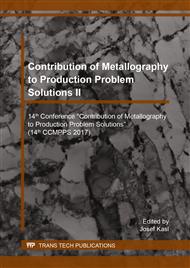[1]
I. Hrivňák, Fractography, STU MTF Trnava, (2009).
Google Scholar
[2]
J. Bezecný, Fractures in steel parts and they relation to production technology, VAAZ Brno – ZŤS Dubnica nad Váhom, (1988).
Google Scholar
[3]
V. Košelev, Fractures in steels, they origin and classification, Metalurgist, no. 11. (1960) p.425.
Google Scholar
[4]
J. Koutský, F. Jandoš, V. Karel, Fractures in steel parts, SNTL, Praha, (1976).
Google Scholar
[5]
P. Levíček, K. Stránský, Metallurgical defects of steel castings, SNTL, Praha, (1984).
Google Scholar
[6]
J. Šenberger, A. Záděra, J. Čech, Contribution to the conchoidal fracture creation after deoxidation Al, Zr, Ti and KVZ. In 49. Foundry days - proceedings. Brno. 2012. pp.62-71. ISBN 978-80-02-02405-7.
Google Scholar
[7]
J. Šenberger, A. Záděra, Z. Carbol, Influence of aluminium, nitrogen and young modulus of casting to conchoidal fracture Steelmakers, 2013, Karlova Studánka.
Google Scholar
[8]
R. Mišičko, S. Longauer, M. Longauerová, Interdendritic fracture at continuous casting of steels, Fractography, Tatranské Matliare, (1987).
Google Scholar
[9]
L. Šmrha, Solidification and crystallization of steel, SNTL, Praha, (1983).
Google Scholar
[10]
J. Bezecný, Fractographical aspects of the inspection of selected steel for special technology, Habilitation thesis, VA Brno, (1991).
Google Scholar
[11]
F. Jandoš, Cracks in segregations in forgings made by several steels, Engineering 39, 1989, 10, s. 608.
Google Scholar
[12]
J. Bezecný, Contribution to problematic of creation of inner, Acta Metallurgica Slovaca, Košice, 3 (1997).
Google Scholar
[13]
J. Bezecný, Creation of crack and fractures at heat treatment of, TnU AD, Trenčín, 2007, ISBN 978-80-8075-202-6.
Google Scholar
[14]
J. Bárta, Tempered Martensite Embrittlement of Ultrahigh-strength Steels, Fraktografia, 22nd International Conference on Heat Treatment, (2015).
Google Scholar
[15]
L. Engel, H. Klingele, Rasterelektronenmikroskopische Untersuchungen von Metallschäden, Carl Hanser Verlag, Műnchen – Wien, (1982).
Google Scholar
[16]
J. Bezecný, M. Kianicová, Causal analysis of failured collar, Fraktografia, (2009).
Google Scholar
[17]
J. Pietikeinen, Observations about tempered martensite embrittlement, Scandinavien journal of Metalurgy, 34, 2005, 1.
Google Scholar
[18]
P. Beťáková, L. Hyspecká, J. Sojka, Quantitative evaluation of hydrogen embrittlement on constructional steels Metal, Hradec nad Moravicí, (2002).
Google Scholar
[19]
J. Bezecný, J. Kučerová, Fractographical Method of Steel Embrittlement Identification by Galvanic Metallization, Machine Dynamics Problems. (2006) Vol. 30, No 3.
Google Scholar
[20]
J. Bezecný, J. Kučerová, I. Letko, M. Polanka, Reduced lifetime reason analysis of plate chain links, 5th Youth SymposiumYSESM, Púchov, (2006).
Google Scholar


